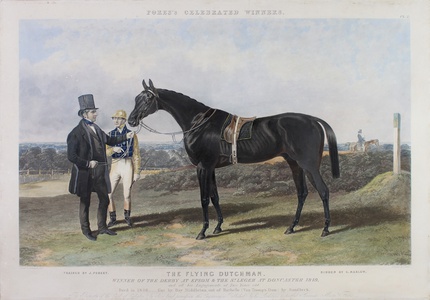| Method | Aquatint with original hand colouring |
| Artist | John Harris after John Frederick Herring |
| Published | Painted by J.F. Herring Senr. Engraved by J. Harris. London, Published August 2nd 1849 by Messrs. Fores, at Their Sporting & Fine Print Repository & Frame Manufactory, 41 Piccadilly, Corner of Sackville Street. |
| Dimensions | Image 445 x 700 mm, Plate 530 x 760 mm, Sheet 545 x 775 mm |
| Notes |
A large separately published illustration of the racehorse The Flying Dutchman, one of a large series of aquatints after paintings by John Frederick Herring of winners of The Derby and The St Leger. The Flying Dutchman, a dark bay horse, is shown with his trainer J. Fobert and his rider, the jockey Charles Marlow. The print was produced to celebrate The Flying Dutchman's wins at both the Derby and the St Leger in 1849. Full title below image reads: 'The Flying Dutchman, Winner of the Derby at Epsom & the St. Leger at Doncaster 1849, and all his Engagements at Two Years old. Bred in 1846, Got by Bay Middleton, out of Barbelle (Van Tromp's Dam) by Sandbeck. The Property of the Earl of Eglinton, by whose kind permission this Engraving is Published by his Lordship's respectful Servants, Messrs. Fores.' John Harris the Younger (1791-1873) was a British mezzotinter, aquatinter, and figure painter, and the son of the painter John Harris the Elder. He is best known as an engraver and lithographer of sporting scenes, though he also exhibited on a variety of subjects at the Royal Academy. John Frederick Herring (1795-1865) was an Anglo-American painter of Dutch descent, best known as a painter of horses. After moving to Doncaster as a young man, he initially worked as a sign-writer and coachman, though his artistic talents gained the attention of a number of his high-profile clients and he began painting racehorses, most famously a series of the winners of the Great St Leger. In 1845 he was made Animal Painter to the Duchess of Kent, a commission that brought him to the attention of Queen Victoria, who became his patron for the remainder of his life. From 1836, he usually appended 'Sr.' to his signature in order to differentiate himself from his son, also a painter of equestrian subjects. Siltzer 147 Condition: Time toning and surface dirt to margins. Minor chips and tears to edges of sheet. Original hand colouring slightly, though evenly, faded. |
| Framing | unmounted |
| Price | £800.00 |
| Stock ID | 51244 |

